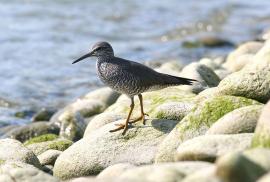Guide to Boreal Birds
Overview
The Wandering Tattler breeds above the timberline in Alaska's rugged mountains, and its nest was not discovered until 1922. Despite its tameness, little is known about its breeding behavior; it is not even known how long the eggs have to be incubated or how long the young are dependent on their parents. These birds are better known on their coastal wintering grounds, where they were discovered more than two centuries ago.
Description
11" (28 cm). A medium-sized sandpiper, uniform gray above, with whitish eyebrow, dark rump and tail, and greenish-yellow legs. Breeding birds have heavily barred underparts. Winter birds whitish below, with a gray wash on sides and flanks.
Voice
A series of 3 or 4 clear whistles, given in flight.
Nesting
4 greenish eggs, marked with dark brown, in a finely built nest of roots, twigs, and dry leaves on a gravel bar in a mountain stream above the timberline.
Habitat
Mountain streams in summer; coastal rocks, shell beaches, and rocky coves in fall and winter.
Range/Migration
Breeds in mountain areas of south-central Alaska and northwestern British Columbia. Winters on Pacific Coast from central California southward.



